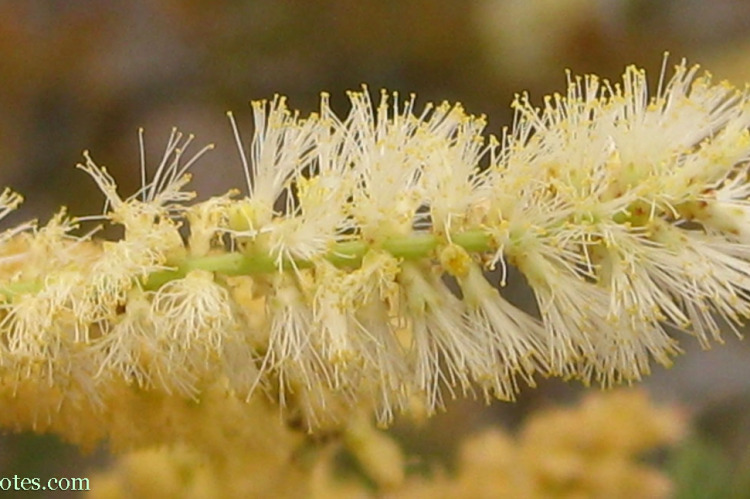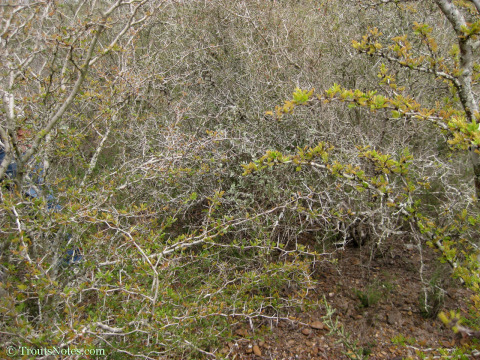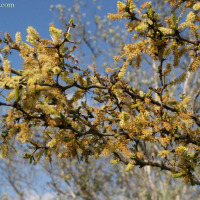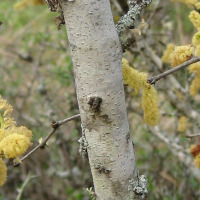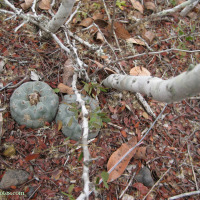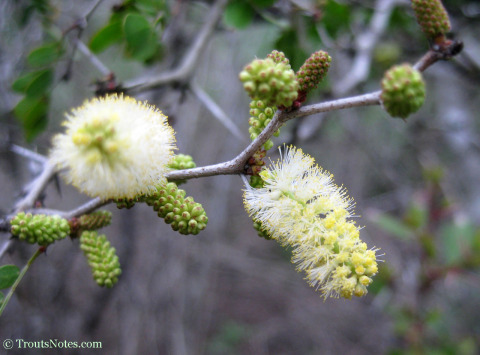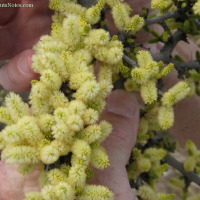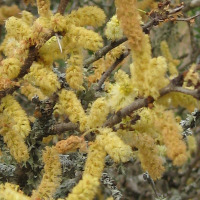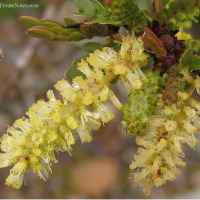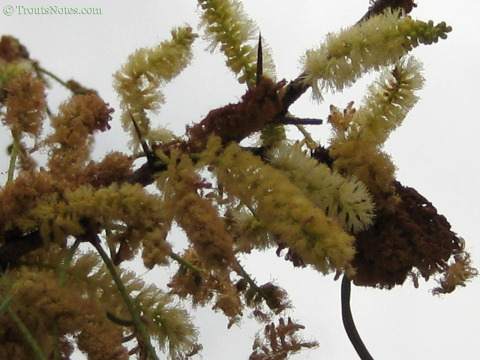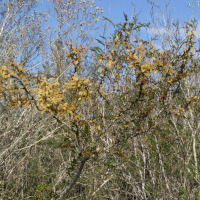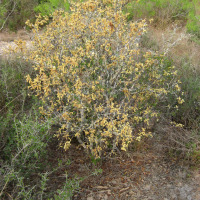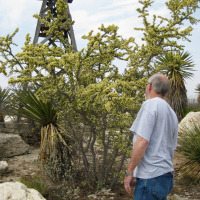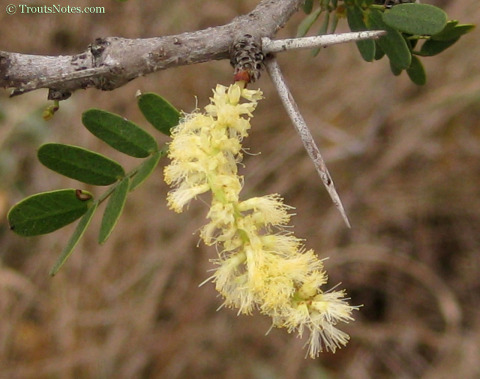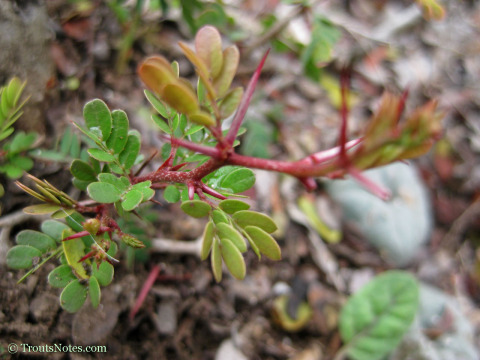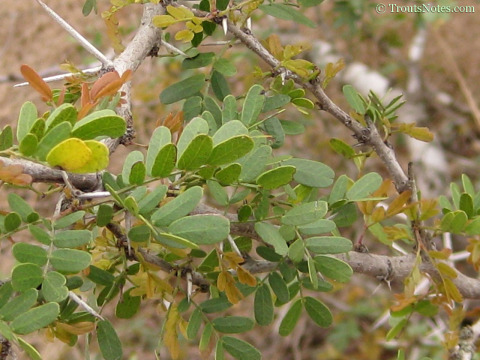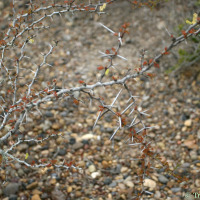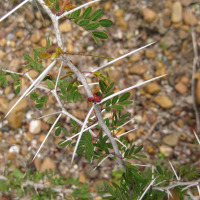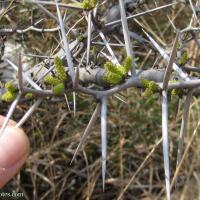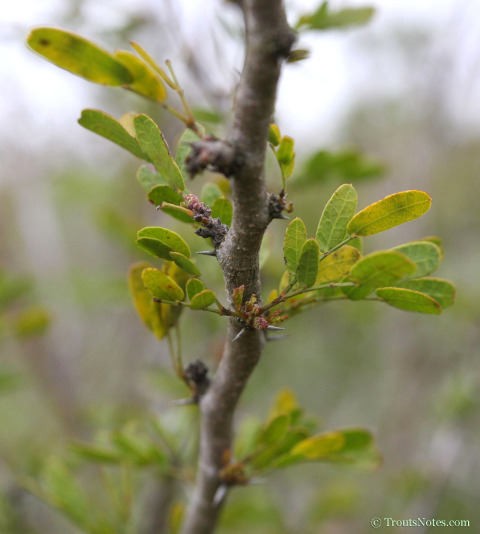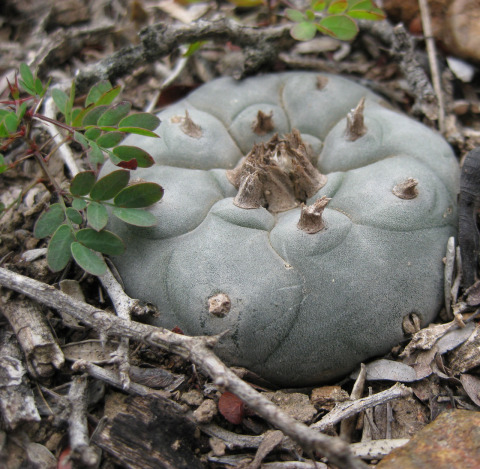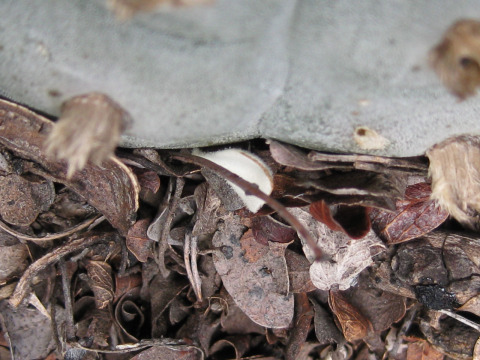Vachellia rigidula (Bentham) Seigler & Ebinger
George Bentham 1842 London Journal of Botany, 1: 504–505, as Acacia rigidula.
David S. Seigler & John E. Ebinger 2006 Phytologia, 87: 166, as Vachellia rigidula.
This is still most often listed in databases and indexing services as Acacia rigidula.
Synonyms of note: Acacia amentacea DC is common as a synonym. (De Candolle 1825 Prodromus Systematis Naturalis Regni Vegetabilis, 2: 455) [Endnote A]
Britton & Rose 1928 North American Flora, 23 (2): 94, described this as Acaciopsis rigidula.
Etymology:
Acacia Merriam-Webster gives as derived from the Greek akakia referring to a “thorny Egyptian tree,” adding it is perhaps related to the Greek word ake meaning “point” or “thorn”.
Acaciopsis means that it looks like an Acacia.
Vachellia “This name honors Reverend G. H. Vachell who collected extensively in China“, Seigler & Ebinger 2006
rigidula is in reference to something being rigid. Bentham probably was referring to the branches. Both the spines and the branches are rigid.
amentacea means “in the form of a catkin” in reference to the flower spikes. according to Stearn (catkin = Amentum).
- Acacia rigidula in Jim Hogg County illustrating why it is called black-brush.
- Acacia rigidula in Starr County
- Acacia rigidula in Jim Hogg County
Common names:
“black brush” (blackbrush/black-brush), “gavia” (Tamaulipas), “chaparro prieto” (Nuevo León, Tamaulipas) [Endnote B]
“Black bush” can also be found listed but should be suspected to be the result of a typo.
Occurrence & Distribution:
Britton & Rose 1928 give as “Southern Texas to Tamaulipas, Nuevo León and San Luís Potosí.” Powell 1998 notes as occurring in northern Mexico to SLP and Tamaulipas, to be abundant in the Rio Grande Plains and through South Texas, also to be common in Val Verde County (1100–1800 ft), occurring in Terrell County, and also more rarely farther West in Brewster County close to the Rio Grande. UTEP: “South Texas and adjacent Tamaulipas, northwest along the plains of the Rio Grande corridor into southeastern Trans-Pecos and south through Coahuila, Nuevo León to San Luis Potosí and Veracruz“.
Habitat:
Dry soils including rocky limestone, calcareous gravelly-loam, loamy, sandy and clay soils. Often found on limestone caliche ridges, slopes, hillsides and canyons. It is a common component of the thorny brush-country of South Texas. Powell 1998, TAMU, UTEP.
- Acacia rigidula cultivated in Val Verde County at Judge Roy Bean Visitor Center
- Acacia rigidula in Starr County
- Acacia rigidula in Jim Hogg County
Original description:
“glabra, ramis flexuosis verrucosis, spinis rectis subulatis, pinnis unijugis, petiolo brevi, glandula scutellæforme, foliolis 4–5-jugis obovati-oblongis obtusis mucronatis coriaceis venosis, spicis cylindricis laxis breviter pedunculatis folio longioribus. Spinæ nunc 1–2-lin. sæpius 6-lin. longæ, interdum pollicares. Foliola 4–5-lin. longa, penninervia. Spicæ pollice longiores. Flores sæpius 4-meri.”
Benson 1842, pp. 504-505.
Description:
Perennial deciduous thicket-forming shrub or small tree, 3–4.5 meters high (UTEP gives as 3′ to 15′ H by 3′ to 12′ W), many long branches arising from a central trunk.
Branches are stiff, commonly zigzagging, with pairs of short, straight and very sharp spines, 0.5-2.8 cm long, sometimes growing up to 5 cm. long. The spines are placed at the base of each petiole (stipular).
Leaves are dark green and bipinnate with “mostly” 1 pair of glabrous pinnae; there are 3–6 pairs of oblong leaflets, 6–15 mm long, the leaflets are obtuse, apiculate and often shining/lustrous, the petiole and rachis are also glabrous and the petiole is gland-bearing;
Inflorescence is axillary with persistent bractlets, small sweetly-fragrant whitish to pale-yellow flowers in short, slender sessile spikes 2–3(–5) cm. long; stamens are numerous, distinct and short;
Fruit is a narrow, curved, flat legume 6–8 cm. long (up to 3-1/8″ long according to Richardson & King 2011), 3-4mm wide. Fruit is 2-valved, with divisions between seeds, readily dehiscent, the valves separating into 2 layers, and covered with minute hairs (puberulent). Black, brown or reddish.
Seeds are oblong, lenticular, their axis parallel with the legume, the funiculus is long. Reddish-brown when ripe.
Adapted from Britton & Rose 1928, Isely 1969, Richardson & King 2011, Stanley 1922, TAMU & UTEP.
[Botanical glossary]
Chromosome number 2n = 26 (Isely 1969 cited Turner 1959 Legumes of Texas)
Flowering:
(Feb.) March, April, May & June. Beginning in Spring before leaves have fully appeared. Isely 1969, Wildflower Center & UTEP. March-April and following rains is a common pattern.
- Acacia rigidula in Jim Hogg County
- Acacia rigidula in Starr County
- Acacia rigidula cultivated in Val Verde County at Judge Roy Bean Visitor Center
Seed collection:
Late summer through early fall when fully ripe. Wildflower Center.
A seed photo is at the USDA website.
Zone:
Said to be hardy to 20°F (UTEP). It is clear that they survive colder temperatures in the wild.
Uses:
Ornamental shrub, thorny barrier hedging, erosion control and renown as a superior honey source. “This tree provides fair grazing for wildlife and poor grazing for livestock“, UTEP.
Other:
Fairly slow growing, responds well to pruning, does best with partial shade.
Published analysis
(Shares a page with Acacia berlandieri)
- Acacia rigidula in Jim Hogg County
- Acacia rigidula in Starr County
- Acacia rigidula cultivated in Val Verde County at Judge Roy Bean Visitors’ Center
Controversy:
1) Diet aids claimed to contain this compound were reported to contain one or more non naturally-occurring amphetamine. (See Pawar et al. 2014) It was suspected this plant may have been chosen as a masking agent to disguise the true nature as being synthetic stimulant additives. No amphetamine of any type could be observed in their samples of the actual plant materials. Known natural sources of amphetamines (such as ephedrine) were also included in some of the formulations such as Ephedra and Sida but they were found to contain synthetic molecules lacking naturally known sources. (See a number of examples of product labels in Cactus Chemistry By Species.)
2) Published analysis by Clement was suggested to be non-reproducible by Pawar et al. 2014. Comments by Shulgin are also noteworthy.
[See Analysis overview.]
References & online resources:
Bentham, George (1842) London Journal of Botany, 1: 318–392, 494–528, “Notes on Mimoseae, with a synopsis of species.”
Britton, Nathaniel Lord & Joseph Nelson Rose (1928) North American Flora, 23 (2): 1–194. “Mimosaceae”.
Clement, B.A. et al. (1998) Phytochemistry, 49 (5): 1377–1380. “Toxic Amines and Alkaloids From Acacia rigidula.” (Beverly A. Clement, Christina M. Goff & T. David A. Forbes)
Correll, Donovan Stewart & Marshall Conring Johnston (1970) Manual of the Vascular Plants of Texas.
Isely, Duane (1969) SIDA, 3 (6): 365-386. “Legumes of the United States. I. Native Acacia.”
Merriam-Webster Dictionary online
http://www.merriam-webster.com/
Pawar, R.S. et al. (2014) Journal of Pharmaceutical and Biomedical Analysis, 88: 457–466. “Determination of selected biogenic amines in Acacia rigidula plant materials and dietary supplements using LC–MS/MS methods.”
Powell, A. Michael (1998) Trees and Shrubs of the Trans-Pecos.
Richardson, Alfred & Ken King (2011) Plants of Deep South Texas.
Shulgin, A.T. “Sasha” (2001) Dear Dr. Shulgin at CCLE (Center for Cognitive Liberties & Ethics) [http://www.cognitiveliberty.org/shulgin/adsarchive/acacia.htm]
Seigler, David S. & John E. Ebinger (2006) Phytologia, 87: 139-178, “New combinations in the genus Vachellia (Fabaceae: Mimosoideae) from the New World.”
Stanley, Paul C. (1922) Trees & shrubs of Mexico, page 376.
Stearn, William (2004) Botanical Latin.
TAMU Plants of the Texas Rangelands (Texas A&M University)
http://essmextension.tamu.edu/plants/plant/blackbrush/
USDA Plants Database
http://plants.usda.gov/core/profile?symbol=ACRI
UTEP (University of Texas at El Paso)
http://museum2.utep.edu/chih/gardens/plants/TtoZ/vachelliarigidula.htm
Ladybird Johnson Wildflower Center website
http://www.wildflower.org/plants/result.php?id_plant=ACBE
Endnotes:
Note A: USDA gives Acacia amentacea DC as a synonym based on that opinion appearing in Stanley 1922. For that reason and the accepted rules of priority, prior to the creation of Vachellia rigidula it was not uncommon to find Acacia rigidula being absorbed into Acacia amentacea. This is a result of the perennial ebb and flow between the viewpoints of lumpers and splitters.
They were distinguished by Correll & Johnson 1970 who believed that “true” Acacia amentacea was limited in distribution to southwestern Mexico.
Isely 1969 considered the Mexican Acacia amentacea to be “almost identical except for fewer leaflets“.
Britton & Rose 1928 listed a number of relatively small differences: straight spines on rigidula versus acicular (needle-shaped) spines on amentacea, a longer maximum length of spines for rigidula (up to 5 cm compared to 1-2.5 cm for amentacea), fewer leaflets on amentaceae (2 pairs compared to 3-6 on rigidula – although it should also be noted that TAMU gives 1-8 for rigidula), the rachis on amentacea is said to be grooved and somewhat pilose as opposed to glabrous on rigidula, with leaflets 10-20 mm long on amentacea compared to 6-15 on rigidula.
Note B: “chapparo” is a Spanish word used for several trees. The Spanish word “prieto”, referring to a “dark-skinned person”, is increasingly falling into disuse in databases, perhaps as it is also commonly used as a derogatory term.

